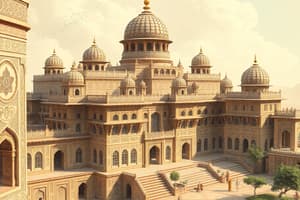Podcast
Questions and Answers
What is the art of making objects from metal, stone, wood, and clay called?
What is the art of making objects from metal, stone, wood, and clay called?
Sculpture
What does the study of images and statues refer to?
What does the study of images and statues refer to?
Iconography
Which ancient civilization is known for its early sculptures?
Which ancient civilization is known for its early sculptures?
- Harappan (correct)
- Mughal
- Mauryan
- Gupta
Which of the following figures is NOT associated with Harappan sculpture?
Which of the following figures is NOT associated with Harappan sculpture?
What process do Harappan people use for bronze casting?
What process do Harappan people use for bronze casting?
What are the two types of Ashokan pillars?
What are the two types of Ashokan pillars?
The __________ pillar has been adopted as a State Emblem by Government of India.
The __________ pillar has been adopted as a State Emblem by Government of India.
How many Ashokan pillars are believed to have originally existed?
How many Ashokan pillars are believed to have originally existed?
Flashcards are hidden until you start studying
Study Notes
Sculpture Overview
- Sculpture involves crafting objects from materials such as metal, stone, wood, and clay.
- Iconography is the study of images and statues.
- The origin of Indian sculpture traces back to the Harappan civilization.
Harappan Sculpture
Metal Figures
- Notable creations include the Dancing Girl and standing woman from Mohenjodaro.
- Harappa features a bullock cart, a one-bull cart, and a scene of a dog attacking a deer.
- Chanhudaro is recognized for its bullock carts.
- Lothal sculptures include figures of an ox, dog, rabbit, and bird.
- Kalibangan is known for its bull representation.
Stone Statues
- Key figures from Mohenjodaro include the Priest/Bearded man and male statue.
- Harappa includes a male torso and a male dancer.
Terracottas
- Featured subjects encompass human forms like Matridevi (Mother Goddess) and various animals such as bulls, buffalo, ducks, and peacocks.
- The bronze Dancing Girl from Mohenjodaro showcases the lost wax process (CIRE PERDUE) used for bronze casting.
Mauryan Sculpture
- Mauryan sculptures are primarily visible in the forms of pillars, stone statues, and terracottas.
Ashokan Pillars
- The Ashokan pillar, a cornerstone of Mauryan art, is a monolithic structure topped with animal figures.
- Originally, there were around 30 Ashokan pillars, 15 of which remain intact.
- Pillars can be classified into two types: with inscriptions and without inscriptions.
Inscriptions
- Pillars with inscriptions can be found at locations including Meerut-Delhi, Allahabad, and Sarnath.
Without Inscriptions
- Examples include the pillars in Rampurva, Kosambi, and Basarh.
Structure of Pillars
- Each pillar consists of a Tapering Shaft and a Capital.
- Tapering Shaft: Carved from a single stone; exhibits fine polish that resembles a mirror.
- Capital: Made separately and affixed to the shaft using a copper dowel; often includes a bell-shaped inverted lotus at the base, an abacus in the middle, and a crown at the top.
Decoration and Significance
- The abacus features engravings of animals, birds, and the Dharma Chakra (Wheel of Law).
- The crowned animal figures on the capitals include lions, bulls, and elephants.
- The Lion Capital of Sarnath is a notable example, serving as the State Emblem of India.
- The Ashokan pillars are renowned for their intricate animal motifs and overall grandeur, exemplifying the artistry of the Mauryan period.
Studying That Suits You
Use AI to generate personalized quizzes and flashcards to suit your learning preferences.




